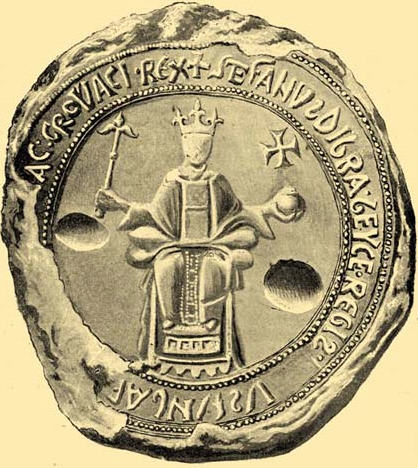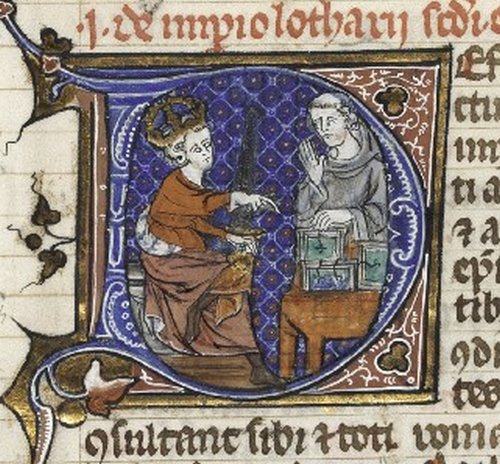|
Stephen II Of Hungary
Stephen II (; ; ; 1101 – early 1131), King of Hungary and King of Croatia, Croatia, ruled from 1116 until 1131. His father, King Coloman, had him crowned as a child, thus denying the crown to his uncle Álmos, Duke of Croatia, Álmos. In the first year of his reign, Republic of Venice, Venice occupied Dalmatia and Stephen never restored his rule in that province. His reign was characterized by frequent wars with neighbouring countries. Early years (till 1116) Stephen and his twin brother, Ladislaus, were sons of the Hungarian king Coloman, King of Hungary, Coloman by his wife, Felicia of Sicily. According to the ''Illuminated Chronicle'', they were born "... in the year of our Lord 1101." Stephen was named after the Stephen I of Hungary, first king of Hungary, who had been canonized in 1083, implying that he was his father's heir from birth. A document written in Zadar in approximately 1105 AD makes mention of "Stephen, our most renowned king" along with Coloman, proving th ... [...More Info...] [...Related Items...] OR: [Wikipedia] [Google] [Baidu] |
János Thuróczy
Johannes de Thurocz (; or ''Ján de Turocz'', , variant contemporary spelling: ''de Thwrocz'') ( – 1488 or 1489), was a Kingdom of Hungary, Hungarian historian and the author of the Latin ''Chronica Hungarorum'' ("Chronicle of the Hungarians"), the most extensive 15th-century work on Hungary, and the first chronicle of Hungary written by a layman. Life Thurocz's parents came from Turóc County (formerly also spelled as Thurocz), Upper Hungary (now Turiec region, Slovakia) where they were members of a yeoman family recorded since the first half of the 13th century (the village of Nedožery-Brezany, Nádasér now Nedožery-Brezany). Johannes' uncle Andreas received a property at Pýr as a donation from King Sigismund of Luxembourg, and Johannes' father Peter inherited this estate. Thurocz was educated in a Premonstratensian monastery in Ipolyság (now Šahy, Slovakia), where he studied Latin and law. In 1465 he appeared in Buda, as a prosecutor of the Premonstraten ... [...More Info...] [...Related Items...] OR: [Wikipedia] [Google] [Baidu] |
Illuminated Chronicle
The ''Chronicon Pictum'' or ''Illuminated Chronicle'' (, , , also referred to as the ''Illustrated Chronicle'', ''Chronica Hungarorum'', ''Chronicon Hungarie Pictum'', ''Chronica Picta'' or ''Chronica de Gestis Hungarorum'') is a medieval illustrated chronicle from the Kingdom of Hungary from the 14th century. It represents the artistic style of the royal court of King Louis I of Hungary. The codex is a unique source of art, medieval and cultural history. The chronicle's full name is: ''Chronicon Pictum – Marci de Kalt Chronica de Gestis Hungarorum'' (Illustrated Chronicle – Mark of Kalt's Chronicle About the Deeds of the Hungarians). History of the chronicle King Louis I of Hungary commissioned the ''Chronicon Pictum'' and the ''Secretum Secretorum'', which were both produced in a Hungarian workshop. Miklόs Meggyesi, son of Hertul the court painter of Louis, has traditionally been identified as the illuminator, though there is no real evidence for this. The Illuminated ... [...More Info...] [...Related Items...] OR: [Wikipedia] [Google] [Baidu] |
Battle Of Olšava
The Battle of Olšava was an engagement of Bohemian and Hungarian troops near the Olšava River along the frontier of the two realms in May 1116. The event started as a peaceful meeting between the young Stephen II of Hungary and Vladislaus I of Bohemia, according to Hungarian chronicles. The Czech Cosmas of Prague Cosmas of Prague (; ; – 21 October 1125) was a Czech priest, writer and historian. Life Between 1075 and 1081, he studied in Liège. After his return to Bohemia, he married Božetěcha with whom he had a son, named Jindřich Zdík, and remai ... wrote that the Hungarians came to the border to provocate a war. References Sources Primary sources *''Cosmas of Prague: The Chronicle of the Czechs'' (Translated with an introduction and notes by Lisa Wolverton) (2009). The Catholic University of America Press. . * Secondary sources * * * * * * Battles involving Hungary Battles involving Bohemia Conflicts in 1116 {{Hungary-hist-stub ... [...More Info...] [...Related Items...] OR: [Wikipedia] [Google] [Baidu] |
Vladislaus I, Duke Of Bohemia
Vladislaus I (; – 12 April 1125) was Duke of Bohemia from 1109 to 1117 and from 1120 until his death. Life Vladislav I was a son of Vratislaus II of Bohemia by his second wife Svatava, a daughter of Casimir I of Poland. Together with his cousin Svatopluk, Vladislav expelled his brother Bořivoj II from Bohemia in 1107. In 1109, Svatopluk was killed during a campaign in Poland, and Vladislav I succeeded him as Duke of Bohemia. Bořivoj II returned from exile with the support of Prince Bolesław III Wrymouth of Poland, but was defeated and imprisoned by Vladislav in 1110. In spite of his victory, Vladislav I remained under Polish pressure and was forced to recognize a younger brother, Soběslav, as subordinate ruler of Moravia in Znojmo. In 1117, Vladislav I formally abdicated in favor of Bořivoj II, but retained much of the actual power. In 1120, Bořivoj was deposed again and endowed with Znojmo, while Vladislav resumed the throne, which he held until his death in 1125. ... [...More Info...] [...Related Items...] OR: [Wikipedia] [Google] [Baidu] |
Lawrence, Archbishop Of Esztergom
Lawrence (; died in 1116 or 1117) was a Hungarian prelate at the turn of the 11th and 12th centuries, who served as Archbishop of Esztergom from around 1105 until his death. He was a faithful confidant of Coloman, King of Hungary and the initiator of large-scale church organizational and canon law reforms in the Kingdom of Hungary. Career Lawrence was born into an unidentified illustrious noble family. He was a member of the royal chapel as one of the court clergymen during the reign of Ladislaus I of Hungary. According to historian Nándor Knauz, he was mentioned in this capacity on 17 April 1093. Literary historian László Mezey argued Lawrence studied at Laon, France during his youth, identifying him with that "''Laurentius Pannonus''", who enrolled in the university in 1100. If this is true, he would be the first known Hungarian cleric who studied abroad. A royal charter from 1111 refers to Lawrence's influence and widespread literacy, who "gladly dealt with sciences". Durin ... [...More Info...] [...Related Items...] OR: [Wikipedia] [Google] [Baidu] |
Przemyśl
Przemyśl () is a city in southeastern Poland with 56,466 inhabitants, as of December 2023. Data for territorial unit 1862000. In 1999, it became part of the Podkarpackie Voivodeship, Subcarpathian Voivodeship. It was previously the capital of Przemyśl Voivodeship. Przemyśl owes its long and rich history to the advantages of its geographic location. The city lies in an area connecting mountains and lowlands known as the Przemyśl Gate (Brama Przemyska), with open lines of transport, and fertile soil. It also lies on the navigable San River. Important trade routes that connect Central Europe from Przemyśl ensure the city's importance. The Old Town of Przemyśl is listed as a List of Historic Monuments (Poland), Historic Monument of Poland. Since the start of the Russian invasion of Ukraine on 24 February 2022, Przemyśl has been a point of refuge for many Ukrainians, as it is located near the Poland–Ukraine border and serves as the end point of the Lviv–Przemyśl railway jun ... [...More Info...] [...Related Items...] OR: [Wikipedia] [Google] [Baidu] |
Coloman
Coloman, ( (also Slovak, Czech, Croatian), , ; ) The Germanic origin name Coloman used by Germans since the 9th century. * Coloman, King of Hungary * Coloman of Galicia-Lodomeria Coloman of Galicia (; ; 1208 – 1241) was the rulerfrom 1214 prince, and from 1215 or 1216 to 1221, the kingof Principality of Galicia, Galicia, and the duke of Slavonia from 1226 to his death. He was the second son of Andrew II of Hungary and G ... (1208–1241) * Coloman, Bishop of Győr (1317–1375) * Saint Coloman of Stockerau (''Koloman, Colman, Colomannus'') (died 1012) * Colomán Trabado Pérez (born 1958 in Vega de Valcarce) * Coloman Braun-Bogdan (1905–1983), a Romanian football midfielder and football manager * Koloman Moser (1868 – 1918), an Austrian artist See also * Kálmán {{given name, Coloman, Colomán Romanian masculine given names English masculine given names Masculine given names ... [...More Info...] [...Related Items...] OR: [Wikipedia] [Google] [Baidu] |
Kievan Rus'
Kievan Rus', also known as Kyivan Rus,. * was the first East Slavs, East Slavic state and later an amalgam of principalities in Eastern Europe from the late 9th to the mid-13th century.John Channon & Robert Hudson, ''Penguin Historical Atlas of Russia'' (Penguin, 1995), p.14–16. Encompassing a variety of polities and peoples, including East Slavs, East Slavic, Norsemen, Norse, and Finnic peoples, Finnic, it was ruled by the Rurik dynasty, founded by the Varangians, Varangian prince Rurik.Kievan Rus , Encyclopædia Britannica Online. The name was coined by Russian historians in the 19th century to describe the period when Kiev was preeminent. At its greatest extent in the mid-11th century, Kievan Rus' stretched from the White Sea in the north to the Black Sea in the south and from the River source, headwaters of the ... [...More Info...] [...Related Items...] OR: [Wikipedia] [Google] [Baidu] |
Henry V, Holy Roman Emperor
Henry V (; probably 11 August 1081 or 1086 – 23 May 1125) was King of Germany (from 1099 to 1125) and Holy Roman Emperor (from 1111 to 1125), as the fourth and last ruler of the Salian dynasty. He was made co-ruler by his father, Henry IV, in 1098. In Emperor Henry IV's conflicts with the imperial princes and the struggle against the reform papacy during the Investiture Controversy, young Henry V allied himself with the opponents of his father. He forced Henry IV to abdicate on 31 December 1105 and ruled for five years in compliance with the imperial princes. He tried, unsuccessfully, to withdraw the regalia from the bishops. Then in order to at least preserve the previous right to invest, he captured Pope Paschal II and forced him to perform his imperial coronation in 1111. Once crowned emperor, Henry departed from joint rule with the princes and resorted to earlier Salian autocratic rule. After he had failed to increase control over the church, the princes in Saxony and o ... [...More Info...] [...Related Items...] OR: [Wikipedia] [Google] [Baidu] |
Chronicon Pictum P106 Álmos Elfogatása
In historiography, a ''chronicon'' is a type of chronicle or annals. Examples are: * ''Chronicon'' (Eusebius) * ''Chronicon'' (Jerome) *''Chronicon Abbatiae de Evesham'' *'' Chronicon Burgense'' *'' Chronicon Ambrosianum'' *'' Chronicon Compostellanum'' *'' Chronicon Gothanum'' *'' Chronicon Helveticum'' *''Chronicon Holtzatiae'' *'' Chronicon Iriense'' *''Chronicon Lethrense'' *''Chronicon Lusitanum'' *''Chronicon Paschale'' *''Chronicon Pictum'' *''Chronicon Roskildense'' *''Chronicon Salernitanum'' *''Chronicon Scotorum'' *'' Chronicon complutense'' *''Chronicon terrae Prussiae ''Chronicon terræ Prussiæ'' () is a chronicle of the Teutonic Knights, by Peter of Dusburg, finished in 1326. The manuscript is the first major chronicle of the Teutonic Order in Prussia and the Grand Duchy of Lithuania, completed some 100 yea ...'' Chronicles ... [...More Info...] [...Related Items...] OR: [Wikipedia] [Google] [Baidu] |




